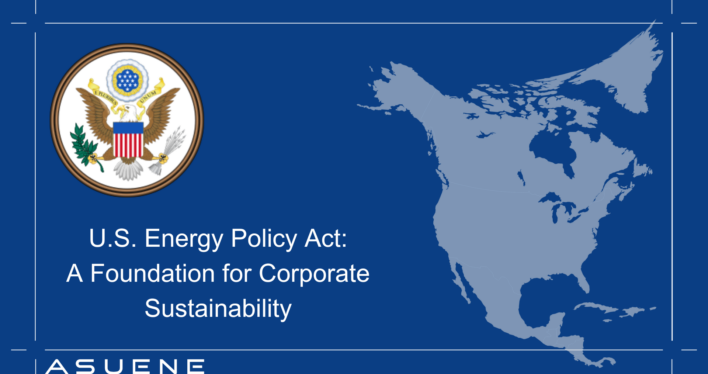- Article Summary
-
Introduction
In the evolving landscape of environmental, social, and governance (ESG) strategy, companies face increasing pressure to align operations with sustainability standards. While voluntary frameworks such as GRI, CDP, or SASB guide ESG reporting, national legislation defines the boundaries of operational compliance and opportunity. Among these laws, the Energy Policy Act (EPAct) remains a cornerstone of U.S. energy efficiency governance.
First introduced in 1992 and comprehensively updated in 2005, EPAct established the federal architecture for improving energy performance across industrial, commercial, and residential sectors. For sustainability officers, ESG analysts, and corporate decision-makers, understanding EPAct is vital for seizing financial incentives, enhancing regulatory preparedness, and strengthening ESG impact.
Legislative Background: EPAct 1992 vs. EPAct 2005

EPAct 1992: The First National Efficiency Framework
The 1992 Act was enacted to address growing concerns about U.S. energy security following the Gulf War. It mandated:
- Minimum efficiency standards for 12 categories of appliances and equipment.
- Fleet fuel diversification, requiring federal agencies and some private fleets to use alternative fuels.
- Federal building energy guidelines, including lifecycle costing for energy decisions.
It laid the groundwork for a nationwide conversation about energy demand reduction, but its implementation was fragmented and limited in financial incentives.
EPAct 2005: A Turning Point for Green Business
The 2005 revision under the Bush administration marked a significant leap:
- Tax deductions and credits for energy-efficient construction and retrofits.
- Loan guarantees and production tax credits (PTC) for renewable energy infrastructure.
- Advanced metering and grid modernization efforts.
- Mandates for renewable fuel usage in federal transportation fleets.
This act marked the federal government’s first substantial effort to use financial mechanisms to drive energy efficiency adoption across sectors.
2. Key Mechanisms of the Energy Policy Act
| Provision | Scope | Impact on Businesses |
|---|---|---|
| Section 179D | Commercial buildings | Up to $1.80/sq ft deduction for 50% energy savings via HVAC, lighting, or envelope improvements |
| Section 45L | Residential developers | $2,500 per dwelling unit for high-efficiency construction |
| Renewable Production Tax Credit (PTC) | Renewable energy producers | Tax credit per kWh generated by wind, solar, or biomass |
| Energy-Efficient Appliance Credit | Manufacturers | Credit for producing certified energy-saving appliances |
| Industrial Efficiency Programs | Manufacturing sector | Technical assistance and grants from DOE’s Advanced Manufacturing Office |
These provisions incentivize companies not only to comply but to invest strategically in sustainable upgrades that reduce operational costs and carbon footprints.
Financial Advantages of Compliance
The most direct benefit for corporations engaging with EPAct is the federal tax relief. For example:
- A 200,000 square foot commercial facility retrofitted to meet 50% energy savings standards under Section 179D can potentially receive $360,000 in deductions.
- Builders of high-performance homes may receive credits for each qualifying unit, creating long-term value for real estate portfolios.
Federal Energy Efficiency Tax Incentives (2005–2020)
Figure 1. Growth in federal efficiency tax incentives reflects increasing prioritization of sustainability in economic policy.
Federal vs. State-Level Efficiency Programs
While EPAct governs the federal baseline, many U.S. states implement their own incentives and stricter While EPAct governs the federal baseline, many U.S. states implement their own incentives and stricter energy codes. For companies operating in multiple jurisdictions, understanding both federal and state programs is essential to optimizing compliance strategies and accessing available financial support.

Below is a comparison highlighting how federal programs under EPAct align—or differ—from notable state-level efficiency initiatives:
Federal vs. State-Level Energy Efficiency Incentives
| Category | Federal Program | State-Level Example |
|---|---|---|
| Commercial Building Tax Deductions | Section 179D Deduction | California Energy Commission Rebates |
| Residential Efficiency Rebates | Energy Star / 45L Tax Credit | New York State NYSERDA Program |
| Appliance Standards | DOE Minimum Standards | California Title 20 / Title 24 |
| Industrial Energy Grants | DOE Office of Industrial Efficiency Grants | Texas EmPOWER Program |
| Renewable Energy Integration | ITC / PTC (Federal Tax Credits) | Massachusetts SMART Solar Program |
This table demonstrates how states not only complement federal mandates but also frequently introduce more ambitious standards, offering businesses additional opportunities for both financial return and ESG advancement. For example, California’s Title 24 building code far exceeds federal energy standards, and New York’s NYSERDA grants provide tailored incentives for multifamily and commercial developers.
By developing a multi-tiered incentive strategy, companies can:
・Localize ESG reporting to reflect regional efforts.
・Stack rebates and credits from multiple levels of government.
・Optimize lifecycle cost analysis for sustainability investments.

Using EPAct to Elevate Sustainability Strategy
A. Environmental Dimension
- Scope 1 & 2 Emissions Reductions: Energy-efficient buildings and equipment reduce direct and indirect emissions.
- Alignment with Science-Based Targets: Energy savings can help meet decarbonization goals validated by SBTi.
B. Social Dimension
- Healthier Work Environments: Better lighting, ventilation, and HVAC performance improve indoor air quality.
- Community Impact: Projects funded by EPAct can revitalize local economies and reduce energy poverty.
C. Governance Dimension
- Risk Mitigation: Proactive compliance reduces regulatory and reputational risks.
- Enhanced Reporting: EPAct-related improvements can be incorporated into ESG disclosures, improving transparency and investor confidence.
Case Studies
Walmart’s Nationwide Retrofit Program
Walmart leveraged Section 179D across hundreds of its stores. The company integrated LED lighting, occupancy sensors, and high-efficiency HVAC systems, reporting over 30% reduction in energy use intensity in retrofitted locations.
Microsoft’s Sustainable Silicon Valley Campus
Microsoft’s new California campus was built with energy optimization in mind. By utilizing EPAct incentives, the project included advanced metering, low-emissivity glass, and renewable integration. Energy use was cut by over 60% compared to similar buildings.
Prologis: ESG and Real Estate
Prologis, a logistics real estate giant, utilized EPAct to fund green warehouse upgrades. As part of its net-zero ambition, the company uses the 179D deduction to improve its ESG ratings and strengthen its investor communications.
Common Barriers and Strategic Solutions
| Barrier | Solution |
|---|---|
| Complexity of tax documentation | Engage certified engineers and tax consultants |
| High upfront investment | Use federal + state + utility incentive stacking |
| Lack of internal ESG capacity | Partner with sustainability advisory firms |
| Fragmented state policies | Build region-specific ESG playbooks |
Proper planning and collaboration can unlock the full potential of EPAct as a strategic asset, not just a compliance obligation.
Future Outlook
The policy environment is evolving rapidly. Under the Inflation Reduction Act (2022), the federal government:
- Extended and increased 179D deductions to $5.00/sq ft in some cases
- Added requirements for prevailing wages and apprenticeships
- Emphasized climate justice and equity in energy spending
Expect to see:
- Greater integration with ESG and climate disclosure regulations
- More incentives tied to GHG intensity reductions
- Enhanced support for clean industrial innovation
Conclusion
The Energy Policy Act has moved from a niche legislative tool to a central pillar of sustainable business strategy in the United States. For ESG professionals, it offers:
- Concrete financial levers to support green infrastructure
- Tangible GHG reductions to meet climate targets
- Stronger governance frameworks for sustainability integration
As global and domestic sustainability expectations continue to grow, aligning with EPAct is not just about tax savings—it is about positioning your company as a leader in the transition toward a low-carbon, high-efficiency economy.
Download Our Expert Publications!

Why Work with ASUENE Inc.?

ASUENE USA Inc., a subsidiary of Asuene Inc., is a key player in carbon accounting, offering a comprehensive platform that measures, reduces, and reports emissions, including Scope 1-3, with expertise in decarbonization. Asuene serves over 10,000 clients worldwide, providing an all-in-one solution that integrates GHG accounting, ESG supply chain management, a Carbon Credit exchange platform, and third-party verification.
ASUENE supports companies in achieving net-zero goals through advanced technology, consulting services, and an extensive network.
